Lasswell Harold D. The Political Writings of Harold D. Lasswell
Подождите немного. Документ загружается.

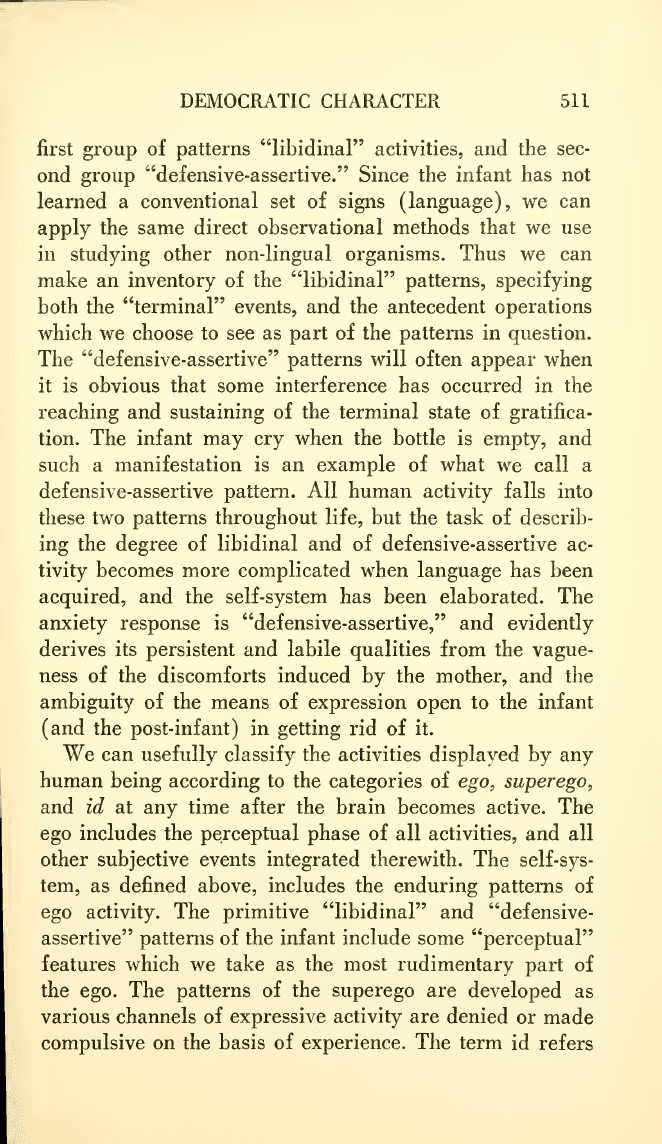
DEMOCRATIC CHARACTER
511
first
group
of
patterns "libidinal" activities, and the
sec-
ond
group "defensive-assertive." Since the infant has
not
learned a
conventional
set of
signs (language),
we
can
apply the same
direct observational methods that we use
in studying other non-lingual
organisms. Thus we can
make
an inventory of the "libidinal" patterns, specifying
both
the
"terminal" events, and the antecedent operations
which we choose to
see as part of the patterns in question.
The
"defensive-assertive" patterns will often appear
when
it is obvious that
some interference
has
occurred in the
reaching and sustaining of
the
terminal state of gratifica-
tion. The infant may
cry
when the bottle is empty, and
such a
manifestation is an
example
of what
we call a
defensive-assertive pattern. All human activity
falls into
these two patterns
throughout
life, but the task
of
describ-
ing the degree of libidinal and of defensive-assertive
ac-
tivity becomes more complicated when
language has been
acquired, and the self-system has been elaborated. The
anxiety response is "defensive-assertive,"
and
evidently
derives its persistent and labile qualities
from the
vague-
ness of the discomforts induced
by the mother, and
the
ambiguity of the means
of
expression
open to the
infant
(and
the post-infant) in getting
rid of
it.
We can usefully classify the activities displayed
by
any
human being according to the
categories of ego,
superego,
and id at any time after the brain becomes
active. The
ego includes the perceptual phase
of all
activities,
and all
other
subjective
events integrated therewith.
The self-sys-
tem,
as defined above,
includes
the
enduring
patterns
of
ego activity.
The
primitive "libidinal"
and "defensive-
assertive"
patterns of the
infant include
some
"perceptual"
features
which
we
take
as
the most rudimentary
part of
the ego. The
patterns of the superego are
developed
as
various channels of
expressive activity
are denied
or
made
compulsive on the
basis of experience. The term
id refers
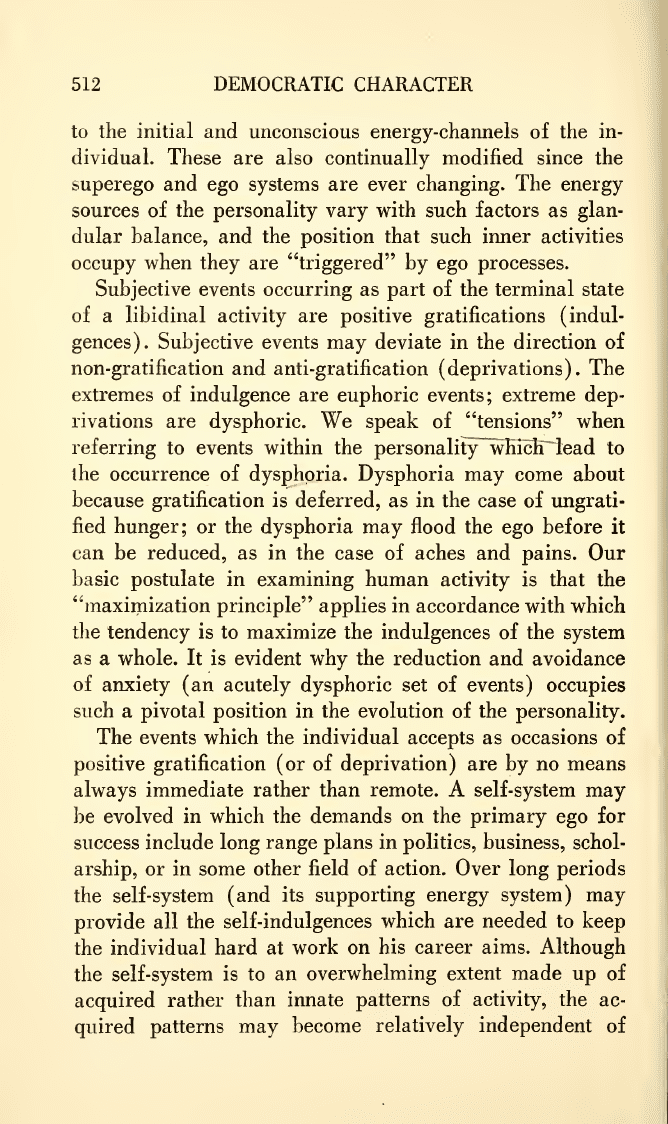
512 DEMOCRATIC CHARACTER
to the initial and unconscious
energy-channels of the
in-
dividual. These are also continually modified since the
superego and
ego
systems are ever changing.
The
energy
sources
of
the personality vary with
such
factors as glan-
dular balance, and the position that
such
inner activities
occupy when they are "triggered" by
ego
processes.
Subjective events occurring
as part of the
terminal state
of
a
libidinal
activity are positive gratifications (indul-
gences). Subjective events
may deviate in the
direction of
non-gratification
and anti-gratification (deprivations). The
extremes
of indulgence are euphoric
events;
extreme
dep-
rivations are dysphoric.
We speak of "tensions" when
referring
to events within the personality^hiclT lead
to
the
occurrence of dysphoria.
Dysphoria may
come
about
because gratification is deferred,
as in the case of ungrati-
fied hunger;
or
the dysphoria
may flood the
ego
before
it
can
be reduced, as in the case of aches and pains.
Our
basic
postulate in
examining
human activity
is that the
"maximization principle"
applies in
accordance with which
the
tendency is to maximize
the indulgences of the system
as
a
whole. It is evident why the
reduction and avoidance
of anxiety
(an acutely dysphoric set of events)
occupies
such
a pivotal position in the evolution
of
the personality.
The events which the individual
accepts as
occasions
of
positive gratification (or of deprivation) are
by no
means
always immediate rather than
remote.
A self-system
may
be
evolved in which the demands on the
primary
ego for
success
include long range
plans
in
politics,
business, schol-
arship, or
in
some other field of
action. Over
long periods
the self
-system (and
its
supporting energy system) may
provide all
the
self-indulgences
which are needed to keep
the
individual hard
at
work on his career
aims.
Although
the
self-system
is to
an
overwhelming extent made
up of
acquired
rather
than innate
patterns of activity, the
ac-
quired
patterns
may
become
relatively independent
of
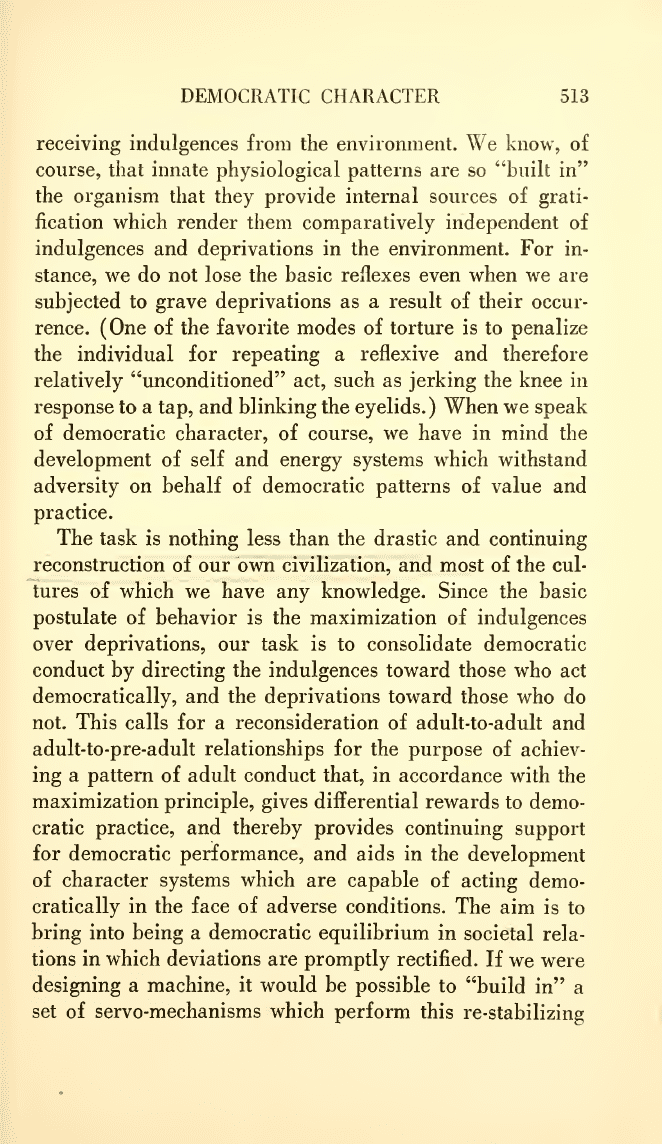
DEMOCRATIC
CHARACTER 513
receiving
indulgences from the environment. We know,
of
course, that innate
physiological patterns are
so
"built
in"
the organism
that they provide internal sources of grati-
fication which render
them comparatively independent
of
indulgences
and deprivations in the environment.
For in-
stance,
we do
not lose the basic reflexes even when
we are
subjected
to
grave deprivations as a result
of
their
occur-
rence. (One
of
the
favorite modes of torture
is to
penalize
the individual for repeating a
reflexive
and therefore
relatively "unconditioned" act, such as
jerking
the knee in
response
to a tap, and
blinking
the eyelids.) When we
speak
of democratic character,
of
course, we
have in
mind
the
development of
self
and energy
systems
which withstand
adversity on behalf of democratic patterns
of
value
and
practice.
The task
is
nothing
less than
the
drastic and continuing
reconstruction
of our own civilization, and most
of
the cul-
tures
of which
we
have any knowledge. Since the basic
postulate
of behavior is the maximization of indulgences
over deprivations,
our task is to consolidate democratic
conduct by directing the indulgences toward those
who act
democratically,
and the deprivations toward those
who do
not. This
calls for a reconsideration of adult-to-adult
and
adult-to-pre-adult relationships
for the purpose
of achiev-
ing a
pattern
of
adult conduct that,
in accordance
with
the
maximization principle, gives differential
rewards
to
demo-
cratic practice, and thereby provides
continuing
support
for democratic performance, and aids in
the
development
of character
systems which
are capable
of
acting
demo-
cratically in the face
of adverse
conditions.
The aim
is
to
bring
into being a
democratic
equilibrium
in
societal
rela-
tions in which deviations are promptly
rectified.
If
we were
designing a machine, it would be possible
to
"build
in"
a
set of
servo-mechanisms which
perform
this
re-stabilizing
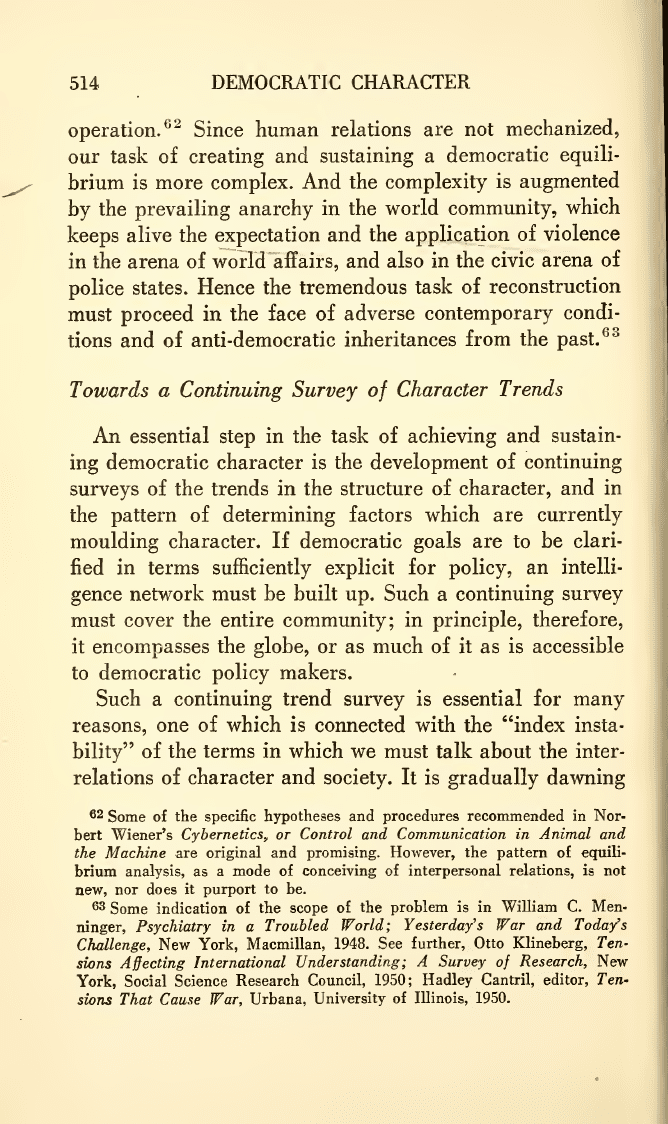
514
DEMOCRATIC
CHARACTER
operation.
^^
Since
human
relations are not
mechanized,
our
task of creating and
sustaining a
democratic
equili-
brium is
more complex.
And the
complexity
is
augmented
by
the
prevailing anarchy
in the
world
community,
which
keeps
alive the
expectation
and the
application
of
violence
in
the arena of
world
affairs, and
also in the
civic
arena of
police
states.
Hence the
tremendous
task of
reconstruction
must
proceed in
the face of
adverse
contemporary
condi-
tions
and
of
anti-democratic
inheritances
from
the
past.^^
Towards a Continuing Survey
of
Character
Trends
An essential step in the task of
achieving and
sustain-
ing
democratic character is the
development of
continuing
surveys
of the trends in the
structure
of
character,
and in
the
pattern
of
determining factors
which are
currently
moulding character. If democratic goals
are to be
clari-
fied
in terms sufficiently explicit for policy,
an intelli-
gence network must be built up. Such
a
continuing
survey
must cover the entire community; in principle,
therefore,
it
encompasses the globe, or
as
much of it as is
accessible
to
democratic
policy makers.
Such a
continuing
trend survey
is
essential for
many
reasons, one of
which
is connected with the "index
insta-
bility" of the
terms in which
we must talk
about
the
inter-
relations of
character and
society. It
is
gradually dawning
82
Some
of
the
specific hypotheses and procedures recommended
in Nor-
bert
Wiener's
Cybernetics, or
Control and Communication in Animal and
the Machine
are original and
promising. However, the
pattern
of
equili-
brium
analysis,
as
a mode
of
conceiving
of
interpersonal relations, is not
new,
nor does
it purport
to
be.
63
Some
indication
of
the scope
of the
problem is in
William
C.
Men-
ninger.
Psychiatry in a
Troubled
World;
Yesterdays War and Todays
Challenge, New
York,
Macmillan,
1948.
See further.
Otto Klineberg, Ten-
sions Affecting
International
Understanding; A
Survey
of
Research,
New
York, Social
Science
Research
Council,
1950;
Hadley Cantril,
editor. Ten-
sions
That Cause
War, Urbana,
University of Illinois, 1950.
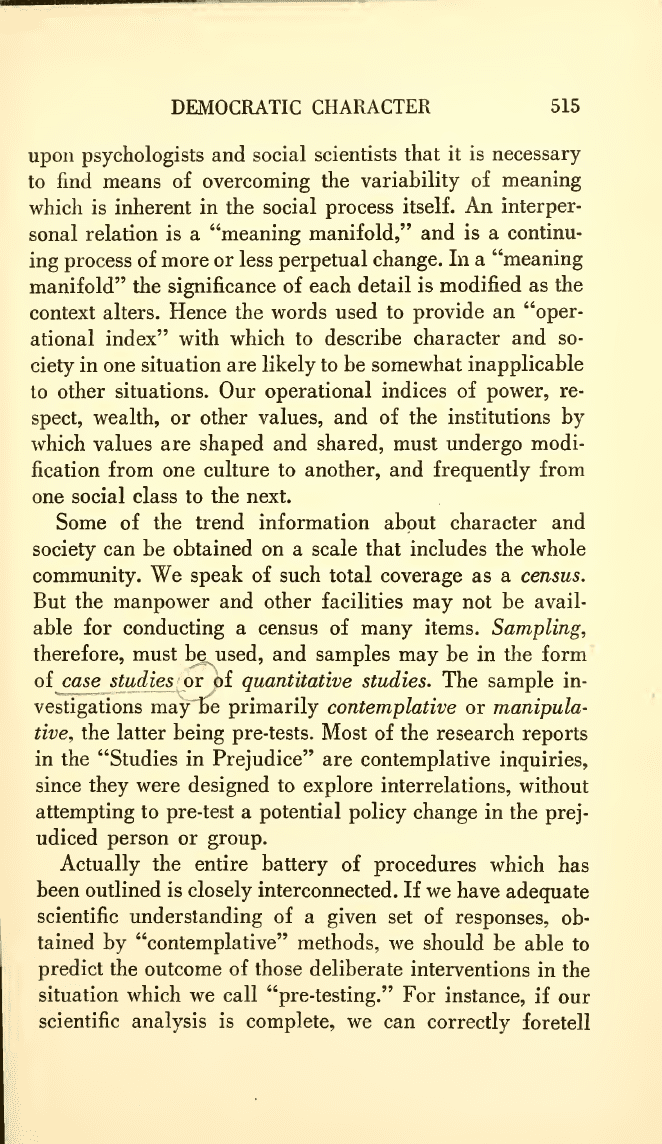
DEMOCRATIC
CHARACTER
515
upon
psychologists
and social
scientists
that it is
necessary
to
find means of
overcoming the
variability
of
meaning
which is inherent
in the social
process
itself.
An
interper-
sonal
relation is a
"meaning
manifold,"
and is a
continu-
ing
process of
more or less
perpetual
change. In a
"meaning
manifold" the
significance of each
detail is
modified as
the
context alters.
Hence the words
used
to
provide an
"oper-
ational
index" with which to
describe
character
and
so-
ciety in
one situation
are likely
to be
somewhat
inapplicable
to other
situations. Our
operational indices of
power, re-
spect,
wealth, or other values, and
of the
institutions
by
which values
are shaped and
shared,
must
undergo modi-
fication
from one culture to
another,
and
frequently from
one social
class to the next.
Some of
the trend information about character and
society can
be
obtained on
a
scale that includes
the
whole
community.
We
speak
of
such total
coverage as a census.
But the manpower and other facilities
may not be
avail-
able for
conducting
a census of many items. Sampling,
therefore, must
be
used,
and samples may
be in
the form
of case studies or
of quantitative studies. The sample in-
vestigations may be primarily
contemplative
or
manipula-
tive, the latter being pre-tests.
Most of the research
reports
in the "Studies in Prejudice"
are contemplative
inquiries,
since they were designed to explore
interrelations,
without
attempting to pre-test
a
potential
policy change
in the prej-
udiced person or
group.
Actually
the
entire
battery
of procedures
which
has
been
outlined is
closely
interconnected.
If we
have
adequate
scientific understanding of
a given
set of
responses,
ob-
tained
by "contemplative" methods,
we
should
be
able to
predict
the outcome
of those
deliberate
interventions
in the
situation
which we call "pre-testing."
For
instance,
if our
scientific
analysis is complete, we
can
correctly
foretell
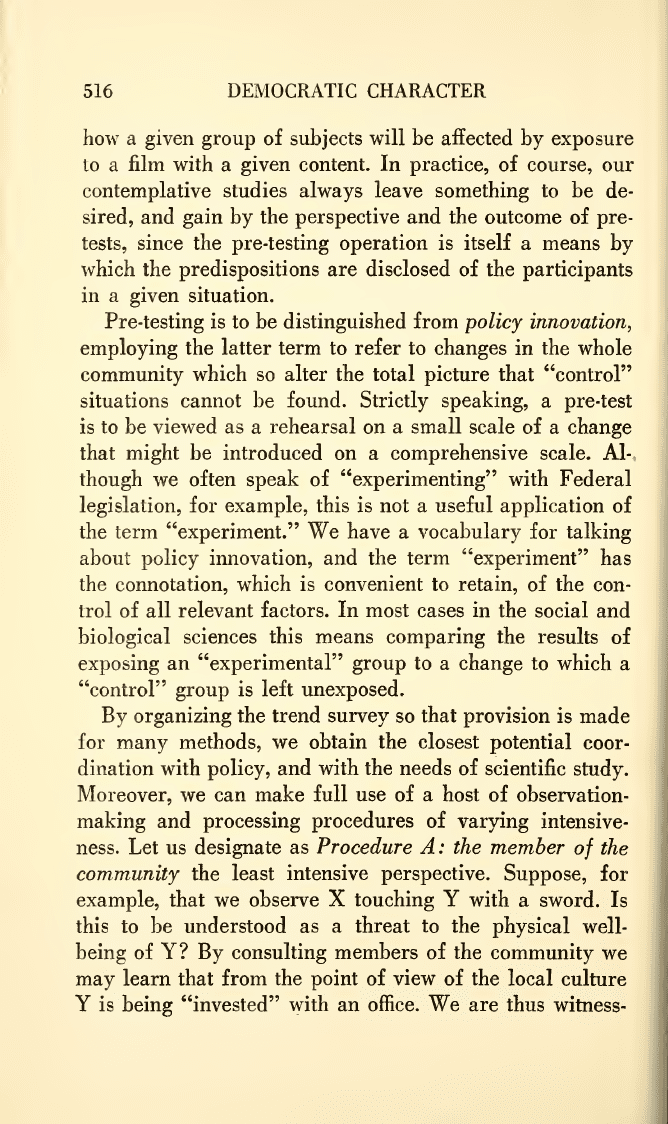
516
DEMOCRATIC
CHARACTER
how a given group of subjects will be affected
by exposure
to a
film with
a
given content. In practice,
of
course,
our
contemplative studies always leave something to be
de-
sired, and gain by the
perspective and
the outcome of pre-
tests,
since the pre-testing operation
is itself a means
by
which the
predispositions are disclosed
of
the
participants
in a given situation.
Pre-testing is
to
be distinguished from policy innovation,
employing the latter
term
to refer to changes
in
the
whole
community which so alter the total picture that
"control"
situations cannot be found. Strictly speaking,
a pre-test
is to be
viewed as
a
rehearsal on a small scale
of a change
that
might be introduced on
a
comprehensive scale.
Al-
though we often speak of
"experimenting" with
Federal
legislation, for
example, this
is not a useful application
of
the
term "experiment."
We have a
vocabulary
for
talking
about policy innovation, and the
term "experiment"
has
the connotation,
which is convenient to retain,
of the
con-
trol of all relevant
factors. In most cases in
the social
and
biological
sciences this means comparing the
results
of
exposing
an "experimental" group to
a change to which
a
"control" group is left
unexposed.
By
organizing the
trend survey
so
that
provision
is made
for many methods, we obtain the closest
potential
coor-
dination with policy, and
with
the needs of
scientific
study.
Moreover, we can make full use of a host
of observation-
making
and
processing
procedures
of varying
intensive-
ness.
Let
us
designate as
Procedure
A
:
the member
of
the
community the
least intensive perspective.
Suppose,
for
example, that we
observe X touching Y
with
a sword. Is
this to be
understood as a threat
to
the
physical
well-
being of Y? By consulting members of the
community
we
may learn that from the point of
view
of the
local culture
Y is being "invested"
with
an
office.
We
are
thus
witness-

DEMOCRATIC
CHARACTER 517
ing an
indulgence of
Y by X in
terms of power. This tells
us
notliing,
obviously, about the
character of X or Y.
But
suppose we
make further inquiries
into the context from
members of
the community.
We
may
discover that the
ad-
vancement of
Y
is
an act of
discrimination against Z,
who
was more
entitled to promotion
than Y. Assume also that
X
is a
public official elected by a
political party
opposed
to the
rapid improvement in the
condition of the
Negroes
(and Z is a Negro). Can
we say at
this point that the
char-
acter of
X
is
undemocratic because he
did
an undemo-
cratic deed? Before
reaching this conclusion it is plainly
necessary
to review the conduct of X as a whole during the
time-internal that we
have chosen for studying X (or the
community). How
does
he act as an employer? As trustee
of
an educational institution? As
a
member
of
an athletic
club? As
a
participant in the social life
of
the
neighbor-
hood?
If
we
draw
all
the data
together
we
can prepare
a
character profile
of
X
based upon
information
pertinent
to democratic values (such
as
X's "discrimination
score").
It
is possible to
intensify
the study of X's character
(and
of characters
in the
community)
by shifting from
the
standpoint
of a
community member
to
that
of a person
who is also an intimate friend. Perhaps
the friend reports
that X is strongly opposed to discrimination,
and that
he
hopes to work into a sufficiently potent
position
to
modify
the traditional program of his
party. It is now possible
to
revise our picture of the character
of
X
from
the observa-
tional standpoint of
Procedure
B: the
intimate
friend.
(We
are not adopting the interpretations made
by the
friend;
we
are sifting his
testimony
about
the
words
and
deeds
of X.)
Our view
of the
character
of
X
may
be
further
intensi-
fied
by
taking
his private picture
of
himself
into
account
(as disclosed, perhaps, in
a
diary
not
meant for
the
eyes
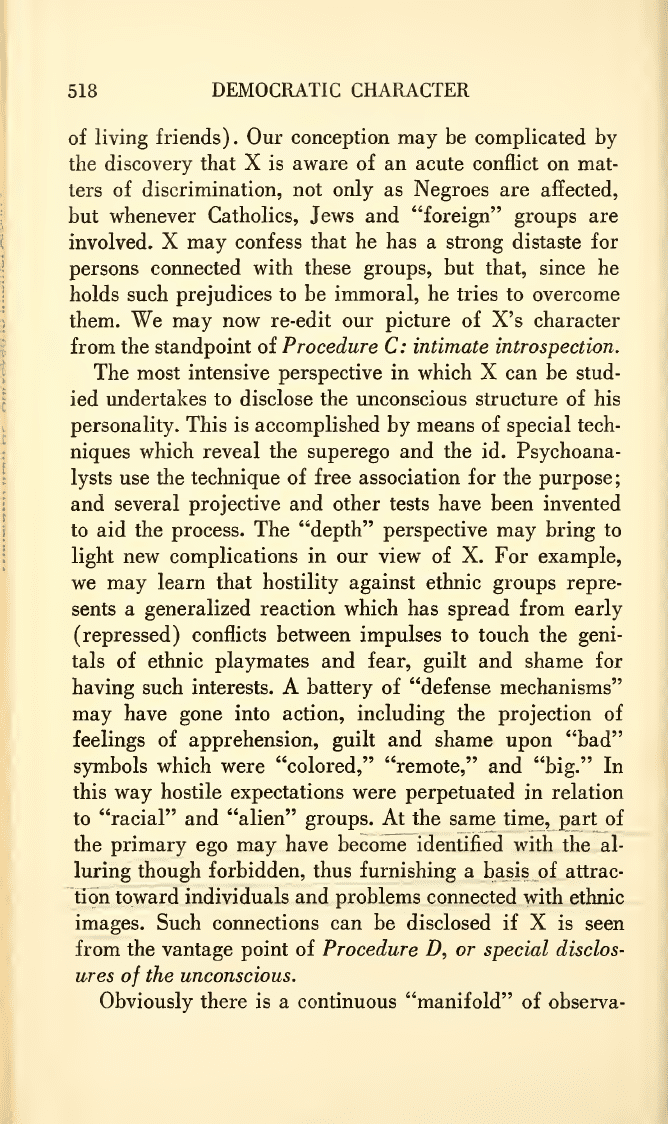
518
DEMOCRATIC CHARACTER
of living
friends). Our
conception
may be complicated by
the
discovery that
X
is
aware of an acute conflict
on mat-
ters of
discrimination,
not only
as
Negroes
are affected,
but
whenever
Catholics,
Jews
and "foreign"
groups
are
involved.
X may
confess that he has
a
strong distaste for
persons
connected with these
groups,
but that, since he
holds such
prejudices to be
immoral, he tries
to
overcome
them. We may
now re-edit our picture
of
X's character
from the
standpoint of Procedure
C:
intimate introspection.
The
most intensive perspective in which X can be stud-
ied undertakes to
disclose the unconscious structure
of
his
personality.
This is accomplished
by
means of special tech-
niques
which reveal the superego and the
id.
Psychoana-
lysts
use the
technique of free association for the purpose;
and
several
projective and
other tests have been invented
to aid the process.
The
"depth"
perspective
may bring to
light new
complications
in our view of
X.
For example,
we may
learn that hostility against ethnic
groups
repre-
sents a
generalized reaction which has spread from early
(repressed) conflicts between impulses to
touch the
geni-
tals of ethnic
playmates and fear, guilt and
shame for
having such
interests. A battery of "defense mechanisms"
may
have gone into action, including the projection of
feelings of apprehension,
guilt
and shame upon "bad"
symbols which
were "colored,"
"remote," and "big." In
this way
hostile expectations were perpetuated
in relation
to
"racial" and "alien" groups. At the same time, part
of
the primary
ego
may have become identified with
the al-
luring though
forbidden, thus furnishing
a
basis
of attrac-
tion toward individuals and problems connected
with ethnic
images. Such connections can be disclosed
if
X
is seen
from the vantage point
of Procedure D, or
special disclos-
ures
of
the unconscious.
Obviously there is a continuous "manifold"
of observa-
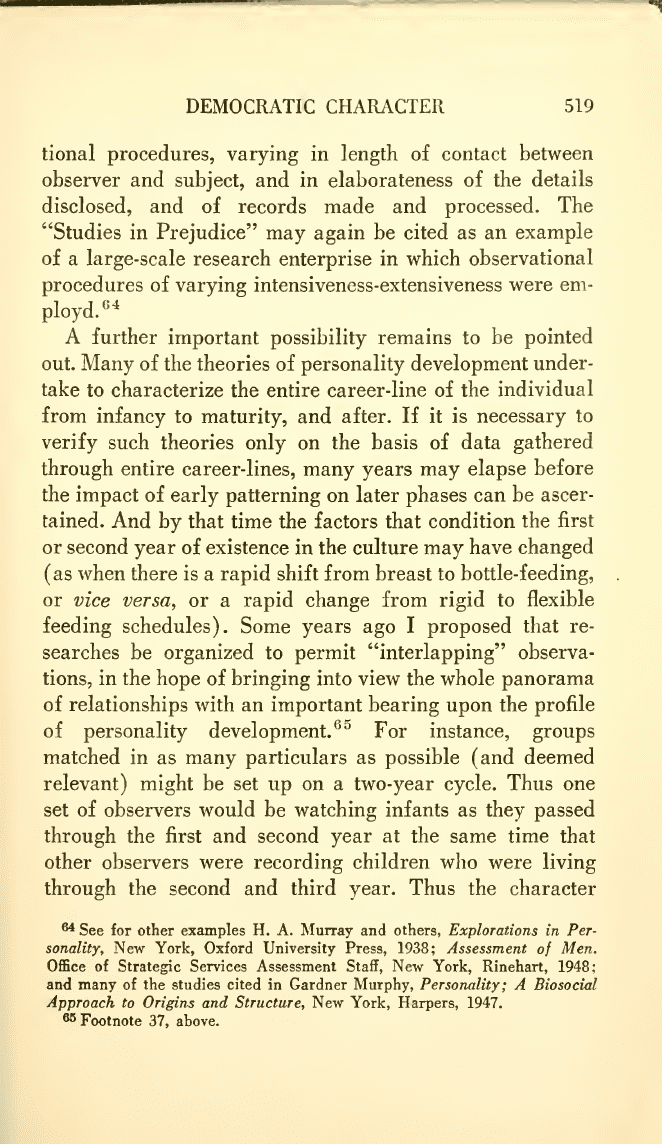
DEMOCRATIC CHARACTER
519
tional procedures, varying
in
length
of
contact
between
observer and subject,
and in
elaborateness of the
details
disclosed, and
of records made
and
processed.
The
"Studies in Prejudice"
may
again
be
cited as
an
example
of
a
large-scale
research enterprise in
which
observational
procedures
of varying intensiveness-extensiveness
were em-
ployd.^'^
A
further
important possibility
remains
to
be
pointed
out. Many of
the theories of personality
development
under-
take
to characterize
the
entire career-line of
the
individual
from
infancy to maturity, and after. If it is
necessary
to
verify
such theories only on the
basis
of
data
gathered
through entire
career-lines, many years may
elapse
before
the
impact
of
early patterning on later phases
can be
ascer-
tained.
And by that
time the factors that
condition
the
first
or
second year
of
existence
in the
culture may have
changed
(as when
there is
a
rapid shift from breast to
bottle-feeding,
or
vice versa, or
a
rapid change from rigid to
flexible
feeding
schedules). Some
years
ago I
proposed that re-
searches
be
organized
to permit
"interlapping" observa-
tions, in the hope
of
bringing into view
the
whole panorama
of relationships with an important bearing upon the
profile
of
personality development.^^ For instance,
groups
matched in as many particulars as possible (and
deemed
relevant) might be set up on a two-year
cycle.
Thus one
set of observers
would
be watching
infants
as they passed
through the
first
and second year at the same time
that
other observers were recording children who were living
through the second and third year. Thus the character
®*
See for other examples H. A. Murray and
others,
Explorations in Per-
sonality,
New York, Oxford University Press,
1938;
Assessment
of
Men.
Office of Strategic Services Assessment Staff, New York,
Rinehart,
1948;
and
many of
the
studies
cited
in Gardner
Murphy,
Personality
; A Biosocial
Approach to Origins and Structure, New York,
Harpers,
1947.
^Footnote
37,
above.
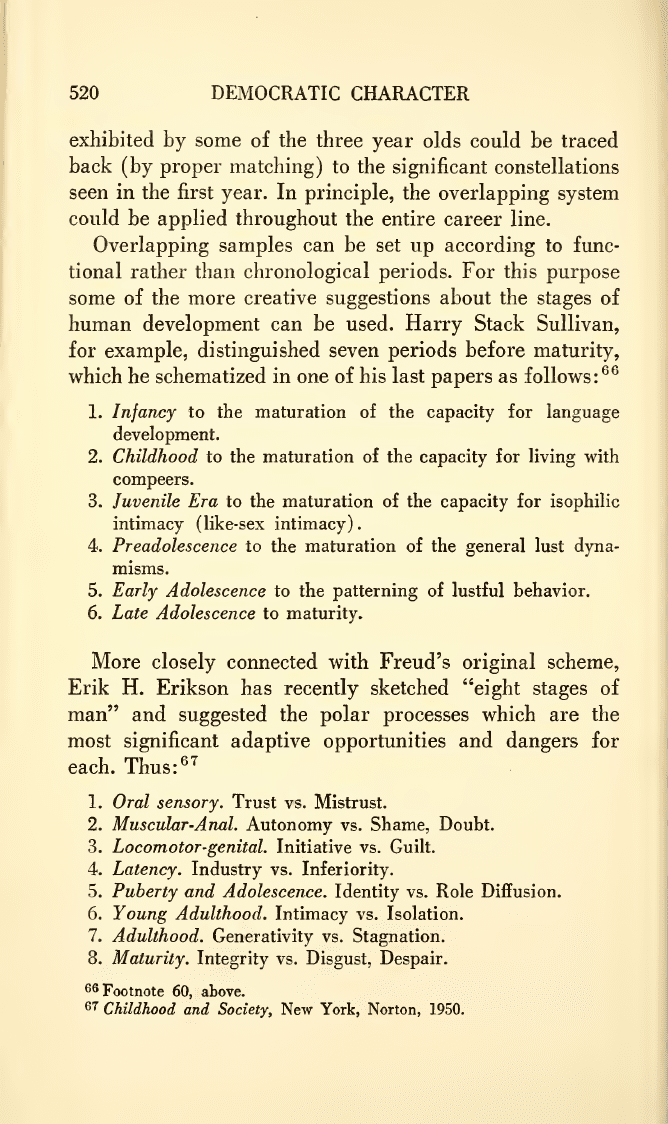
520
DEMOCRATIC
CHARACTER
exhibited
by some
of the three
year
olds could be
traced
back
(by
proper
matching)
to the significant
constellations
seen in the first
year. In principle,
the overlapping system
could
be
applied throughout
the entire
career line.
Overlapping
samples can be set up according
to func-
tional
rather
than chronological periods. For this
purpose
some of the more
creative suggestions about the stages
of
human
development can be used. Harry Stack Sullivan,
for example,
distinguished seven periods before maturity,
which he schematized in one of
his last papers
as follows
:^^
1. Infancy
to
the
maturation of the capacity for
language
development.
2. Childhood to the
maturation of the capacity
for
living with
compeers.
3. Juvenile Era to the maturation
of
the capacity for isophiHc
intimacy (like-sex intimacy).
4.
Preadolescence
to the maturation of the general lust dyna-
misms.
5.
Early Adolescence
to the
patterning of lustful behavior.
6.
Late Adolescence
to
maturity.
More closely
connected
with Freud's
original
scheme,
Erik
H. Erikson
has
recently sketched "eight
stages
of
man" and
suggested the
polar processes which are the
most significant adaptive opportunities and dangers
for
each. Thus:^'^
1. Oral sensory. Trust
vs. Mistrust.
2. Muscular-Anal. Autonomy
vs.
Shame, Doubt.
3. Locomotor-genital.
Initiative vs.
Guilt.
4.
Latency. Industry
vs.
Inferiority.
5. Puberty and Adolescence. Identity
vs. Role
Diffusion.
6.
Young
Adulthood. Intimacy
vs.
Isolation.
7.
Adulthood. Generativity vs. Stagnation.
8. Maturity.
Integrity vs. Disgust, Despair.
^®
Footnote
60,
above.
67
Childhood
and
Society,
New York,
Norton,
1950.
